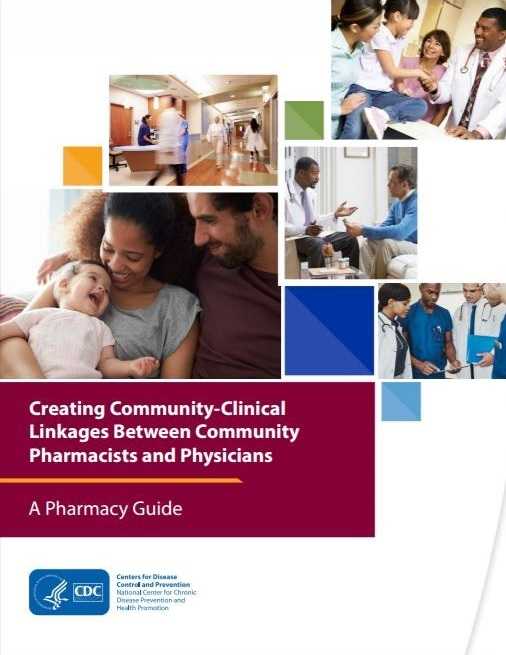Guides
CDC’s Division for Heart Disease and Stroke Prevention developed guides to support program and evaluation managers, health professionals, pharmacists, and community health workers in their heart disease and stroke prevention efforts.
Public Health Practitioner Guides
These guides cover a wide range of topics to help health professionals prevent and control of heart disease and stroke in their communities.
-
Addressing Chronic Disease through Community Health Workers: A Policy and Systems-Level Approach [PDF–715K]
This resource provides evidence demonstrating the value and impact of CHWs in preventing and managing a variety of chronic diseases. In addition, this resource includes descriptions of chronic disease programs that are engaging CHWs, examples of state legislative action, and resources to build an integrated and sustainable CHW workforce. -
Community-Clinical Linkages for the Prevention and Control of Chronic Diseases: A Practitioner’s Guide [PDF-1.7M]
This guide is a resource for public health practitioners to define and facilitate community-clinical linkages. -
Self-Measured Blood Pressure Monitoring Action Guide [PDF-1M]
Self-measured blood pressure monitoring plus additional clinical support is a strategy that can reduce the risk of disability or death from high blood pressure. The purpose of this guide is to help clinicians implement self-measured blood pressure monitoring in their practices by providing evidence-based action steps and resources.
Pharmacy Guides
These guides include resources and information for health professionals partnering with pharmacists as well as tools and strategies pharmacists can use to improve patient care.
-
Collaborative Practice Agreements and Pharmacists’ Patient Care Services Resources
This set of guides informs health care providers, decision-makers, insurers, and pharmacists about the role of pharmacists in team based care. The guides help put science into practice by including strategies and case examples of how pharmacists and other health care providers can better serve patients through collaborative practice agreements and collaborative drug therapy management. -
Methods and Resources for Engaging Pharmacy Partners [PDF-765K]
This publication provides public health departments with methods and resources they can use to engage pharmacy partners to enhance team-based care and form community-clinical linkages. It highlights methods that can be used to develop and expand partnerships between health departments and pharmacies, as well as complementary pharmacy resources. -
Using the Pharmacists’ Patient Care Process to Manage High Blood Pressure: A Resource Guide for Pharmacists [PDF-633K]
The Pharmacists’ Patient Care Process is a way to prevent and manage high blood pressure through team-based care. This guide provides information about current resources and emerging practices, as well as tools and examples that pharmacists can use to help improve health outcomes associated with cardiovascular disease. -
Creating Community-Clinical Linkages Between Community Pharmacists and Physicians: A Pharmacy Guide [PDF-1.1M] | High-Resolution [PDF-6.4M]
This guide describes a framework for creating linkages between community pharmacists and physicians that benefit community collaborators and the patients they serve. This resource serves as a supplement to Community-Clinical Linkages for the Prevention and Control of Chronic Diseases: A Practitioner’s Guide [PDF-1.6M].
Evaluation Basics Guide Series
CDC developed this series of five evaluation technical assistance tools to highlight evaluation strategies and successful examples.
Policy Guides
Moving Into Action: Promoting Heart-Healthy and Stroke-Free Communities (Part of the Public Health Action Plan)
This guide is a series of action items designed to help governors, state legislators, local officials, employers, and health care leaders promote heart–healthy and stroke–free communities. Included are examples gathered from states and communities that are working to reduce these risks and a summary of the science underlying heart disease and stroke prevention.
Data Resource Guides
These data resource guides cover a wide range of topic for the prevention and control of heart disease and stroke in communities.
-
Data Set Directory of Social Determinants of Health at the Local Level
This directory contains an extensive list of existing data sets that can be used to address social health determinants. The data sets are organized according to 12 broad categories of the social environment. -
Surveillance and Evaluation Data Resource Guide for Heart Disease and Stroke Prevention Programs [PDF-298K]
This guide is an at-a-glance compilation of data sources useful for heart disease and stroke prevention programs conducting policy or data surveillance and/or evaluation. It is meant to be used by program managers and evaluators in the planning and evaluation stages of prevention programs.
Prevention Guides
These guides are designed for health professionals and community workers to use in their heart disease and stroke prevention programs.
-
Heart-Healthy and Stroke-Free: A Social Environment Handbook
In this handbook, public health professionals, advocacy groups, and community and state leaders will find specific ideas and strategies for identifying barriers and promoters for heart-healthy and stroke-free living in local environments. Although many public health tools are available for “community diagnosis,” this handbook is unique because of its focus on prevention and treatment of heart disease and stroke. -
Prevention Works: CDC Strategies for a Heart-Healthy and Stroke-Free America
This guide provides a snapshot of heart diseases and stroke prevention at the Centers for Disease Control and Prevention. It also provides information on the health and economic costs of chronic diseases to the nation and outlines CDC’s prevention strategies.
- Page last reviewed: August 28, 2017
- Page last updated: August 28, 2017
- Content source:



 ShareCompartir
ShareCompartir
